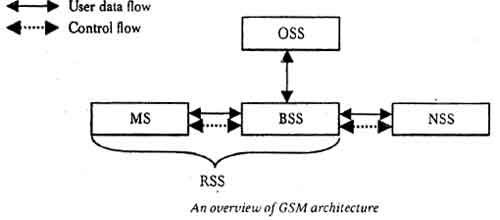In the beginning around 1980s, analog cellular telephone systems were developing in Europe and each country was developing its own system and thus making them confined within their country boundaries. Later on, the need for an European public land mobile system was realized. In 1982, the Conference of European Posts and Telegraphs (CEPT),formed a study group called the Groupe Special Mobile (GSM) to develop a pan-European standard With the objectives of providing good subjective speech quality, support for international roaming etc. The proposed system was expected to meet certain criteria as mentioned below:
- Good subjective speech quality
- Low terminal and service cost
- Support for international roaming
- Ability to support handheld terminals
- Support for a range of new services and facilities
- Spectral efficiency
- ISDN compatibility.
Subsequently, European Telecommunication Standards Institute (ETSI) published phase I of the GSM specifications in 1990; by 1993there were 36 GSM networks deployed in 22 countries and gradually over 200 GSM networks including DCS1800 and PCSI900 around the world. With the entry of North America, GSM systems now exist on every continent, and GSM is now known as Global System for Mobile communications. The analog cellular systems like AMPS in the United States and TACS in the United Kingdom were replaced as digital system keeping in view the advantages of digital system in compression algorithms and digital signal processing allover the world.
In brief, we may now say that GSM is a digital mobile communications system based on European standard which has been defined within the framework of the European Telecommunications Standards Institute (ETSI), and in to meantime has been adopted by 396 network operators in 150 countries. It was designed to be compatible with ISDN systems and the services provided by GSM are a subset of the standard ISDN services (speech is the most basic).
We’ll be covering the following topics in this tutorial:
General Features of GSM
GSM (Global System for Mobile Communications) is a second-generation (2G) digital mobile telephones standard using a combination Time Division Multiple Access (TDMA) and Frequency Division Multiple Access (FDMA) to share the bandwidth among as many subscribers as possible.
- GSM provides only 9.6 kbps data connection. Increase in data rates can be achieved when GSM changes into a radio service based on wide band code division multiple access, and not TDMA.
- GSM digitizes and compresses voice data, then sends it down a channel with two other streams of user data, each in its own time slot. It operates at either the 900, 1800 or 1,900 MHz frequency bands.
- The uplink and down link frequencies for GSM are different and therefore a channel has a pair of frequencies 80 MHz apart. The separation between uplink and downlink frequencies is called duplex distance.
- In a channel the separation between adjacent carrier frequencies is known as channel separation which is 200 kHz in case of GSM.
- The services supported by GSM are telephony, fax and SMS, call forwarding, caller 10, call waiting and the like.
- GSM supports data at rates up to 9.6 kbps on POTS (Plain Old Telephone Service), ISDN, Packet Switched Public Data Networks, and Circuit Switched Public Data Networks.
- The access methods and protocols for GSM may be fromX.25 or X.32.
- Being a digital system, GSM does not require a modem between subscriber and GSM network. However, an audio modem is required inside the GSM network to establish connection with POTS.
GSM Subscriber Services
There are three basic types of services offered through GSM. These are telephony or teleservices, data or bearer services and supplementary services. Bearer service provides the necessary data or control signal for different entities and interfaces. An interface is an access point between two entities, which will be described subsequently under GSM architecture. Telephony services comprise voice services between different subscribers. The supplementary services are used to enhance the features of bearer and teleservices. In this way GSM provides the following services to subscribers:
- Dual-tone multi frequency (DTMF) DTMF signals are tone signals used for various control purposes via the telephone network and are different from dial pulses. This can pass through the entire channels to the subscriber and therefore, offer itself to various schemes for remote control after the connection is established. One example is the remote control of an answering machine.
- Short message services (SMS) SMS is a message consisting of a maximum of 160 alphanumeric characters. SMS can be sent to or from a mobile station even when the subscriber’s mobile station is powered off or .has left the coverage area. In this case the message is stored and offered back to the subscriber when the mobile station is powered on or the subscriber has come back to the coverage area of the network.
- Facsimile group III GSM supports CCITT Group 3 facsimile. A special fax converter in the GSM system enables a fax connected with GSM to communicate with any analog fax in the network.
- Call forwarding This is a supplementary service, which enables a subscriber to forward incoming calls to another number on his own convenience.
The other services are cell broadcast, voice mail, fax mail, barring of outgoing and incoming calls conditionally, call hold, call waiting, conferencing, closed user groups etc.
GSM consists of many subsystems, such as the Mobile Station (MS), the Base Station Subsystem (BSS), the network and switching subsystem (NSS) and the Operation Subsystem (OSS). Mobile Station (MS), the Base Station Subsystem (BSS) together forms a radio subsystem.

[/vc_column_text][/vc_column][/vc_row]
 Dinesh Thakur holds an B.C.A, MCDBA, MCSD certifications. Dinesh authors the hugely popular
Dinesh Thakur holds an B.C.A, MCDBA, MCSD certifications. Dinesh authors the hugely popular